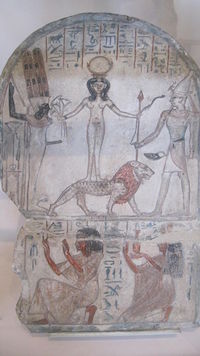
Qadesh (Qedesh, Kadesh, Qetesh, Qudshu) was originally a Semitic deity whose worship was imported into Egypt during the New Kingdom. She was a goddess of nature, beauty and sexual pleasure. Originally, her husband was the god Reshep, a Syrian deity whose worship was introduced to Egypt during the Middle Kingdom.
When her worship spread to Egypt she was associated with the fertility god Min. Min and Reshep were worshipped as a triad with Qadesh in which she was either the wife of both gods or the wife of Reshpu and the mother of Min.

Qadesh was originally depicted as a naked woman standing on the back of a lion (outside Egypt it is sometimes a horse) with a crescent moon on her head. After her adoption into the Egyption pantheon she was more commonly depicted wearing the headdress of Hathor or a pair of cows horns and a sun disc (also linked with Hathor and the “Eye or Ra”) and a tight-fitting sheath dress.
She was often shown holding snakes (thought to represent male genitalia) or a papyrus plant (representing Reshep) in her right hand and lotus flowers (representing either female genitalia or Min) in her left hand. Like Bes and Hathor, she is always pictured facing forward rather than in profile.
Her name is possibly related to the hebrew word “qedesh”. The meaning of the word is problematic. It is often translated as “holy woman” and (according to some) refers to the sacred prostitutes of the cult of Asherah known as Quedeshot (the Semitic nature goddess who was associated with Hathor in Egypt). In fact, Qadesh is sometimes thought of as an aspect of Asherah rather than a distinct goddess. However, other scholars have suggested that she was a distinct goddess and that the connection with prostitution is due to early mistranslations of biblical texts. They suggest that actually the word related to temple staff, and held no sexual association.
Bibliography
- Pinch, Geraldine (2002) Handbook Egyptian Mythology
- Wilkinson, Richard H. (2003) The Complete Gods and Goddesses of Ancient Egypt
Copyright J Hill 2016